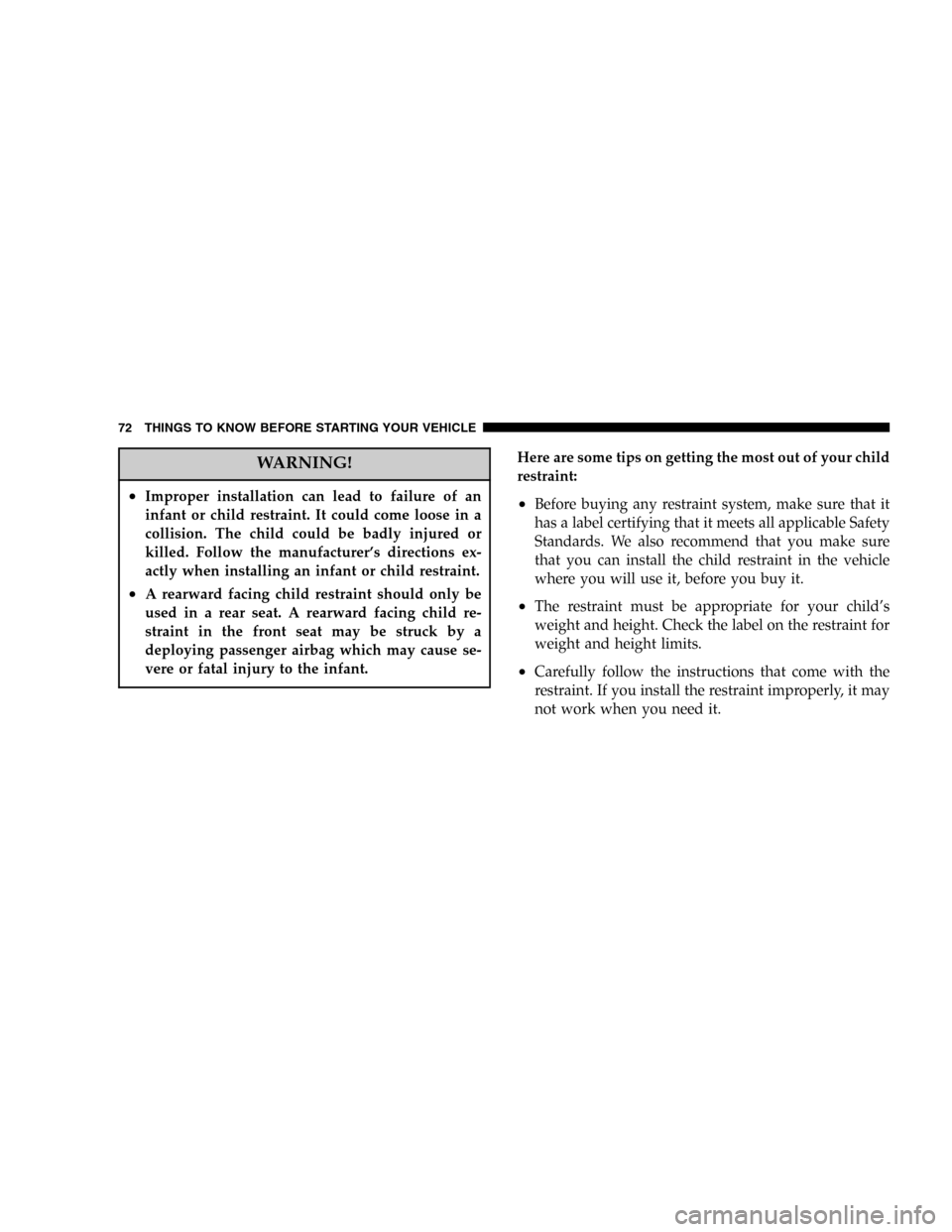Page 61 of 480

•If your vehicle contains a Passenger Airbag Disable
indicator light, it will be equipped with theOccupant
Classification System (OCS).The OCS system will
classify an occupant into a size category based on
sensor readings from within the seat cushion. Occu-
pants should try to remain in a normally seated
position. If the occupant’s weight is transferred to
another object in the vehicle (i.e. feet on the dash-
board), the OCS may not be able to properly approxi-
mate occupant size. Furthermore, the occupant size
may appear to increase or decrease due to objects
hanging on the seat, other passengers pushing on the
seat, or objects lodged underneath the seat. Ensure
that the front passenger seat back does not touch
anything placed on the back seat because this can also
affect occupant classification. Also, if you fold down
the rear seat, check to be sure it doesn’t touch the front
passenger seat.If there is a rapid change in temperature or humidity,
the OCS may not be able to properly approximate
occupant size. If your seat including your trim cover
and cushion needs to be serviced in any way (includ-
ing removal or loosening/tightening of seat attach-
ment bolts), take the vehicle to your authorized dealer.
Only manufacturer approved seat accessories may be
used.
If there is a fault present in the system, the AIRBAG
warning light will illuminate indicating that you should
take the vehicle to an authorized dealer. In the presence
of an occupant in the passenger seat, if both the PAD
indicator light and AIRBAG warning light are illumi-
nated the airbag will be disabled.
The ORC will not allow front airbag deployment in the
event of a collision for occupants classified into the
empty or child size categories. The PAD indicator light
will illuminate indicating that the Passenger Airbag is
THINGS TO KNOW BEFORE STARTING YOUR VEHICLE 61
2
Page 63 of 480

•TheOccupant Classification Module (OCM)—If
Equippedis located beneath the front passenger seat.
The OCM classifies the occupant into one of three size
categories based on the input from the Bladder Assem-
bly and Belt Tension Sensor. The size categories in-
clude empty, child, and adult. The OCM sends the
Occupant Classification to the ORC to identify if a
front passenger airbag is allowed. If a fault is present,
the AIRBAG warning light is illuminated.
•ThePassenger Airbag Disabled (PAD) Indicator
Light—If Equippedindicates to the driver and
passenger when the airbag is turned OFF in the
presence of a properly seated occupant. When the PAD
indicator light is illuminated, the airbag is OFF. Also,
when the Occupant Classification System detects ei-
ther an empty seat or a weight less than the predeter-
mined occupant threshold, the ORC will not illumi-
nate the PAD indicator light even though the airbag isturned OFF. When the ocs system detects an adult the
PAD indicator light will be off, and the airbag will be
enabled.
•TheBelt Tension Sensor (BTS)—If Equippedis
located at the outboard passenger lap belt anchor. The
BTS generates a signal based on outboard lap belt
tension. This signal is sent to the OCM to ensure that
the resultant bladder pressure increase due to applied
lap belt tension does not cause a small occupant to be
classified as a larger occupant.
•TheBladder Assembly—If Equippedis located
beneath the seat cushion foam. The pressure sensor
sends a signal to the OCM.
The front passenger seat assembly contains critical com-
ponents that affect the front passenger airbag deploy-
ment. Correctly functioning front passenger seat compo-
nents are critical for the Occupant Classification System
THINGS TO KNOW BEFORE STARTING YOUR VEHICLE 63
2
Page 70 of 480

Infants and Child Restraints
•
Safety experts recommend that children ride
rearward-facing in the vehicle until they are at least
one year old and weigh at least 20 lbs (9 kg). Two types
of child restraints can be used rearward-facing: infant
carriers and�convertible�child seats. Both types of
child restraints are held in the vehicle by the lap/
shoulder belt or the LATCH child restraint anchorage
system. Refer to“Lower Anchors and Tether for CHil-
dren (LATCH)”later in this section.
•The infant carrier is only used rearward-facing in the
vehicle. It is recommended for children who weigh up
to about 20 lbs (9 kg).�Convertible�child seats can be
used either rearward-facing or forward-facing in the
vehicle. Convertible child seats often have a higher
weight limit in the rearward-facing direction thaninfant carriers do, so they can be used rearward-facing
by children who weigh more than 20 lbs (9 kg) but are
less than one year old.
•Rearward-facing child seats mustNEVERbe used in
the front seat of a vehicle with a front passenger
airbag. An airbag deployment could cause severe
injury or death to infants in this position.
Older Children and Child Restraints
•Children who weigh more than 20 lbs (9 kg) and who
are older than one year can ride forward-facing in the
vehicle. Forward-facing child seats and convertible
child seats used in the forward-facing direction are for
children who weigh 20 to 40 lbs (9 to 18 kg) and who
are older than one year. These child seats are also held
in the vehicle by the lap/shoulder belt or the LATCH
child restraint anchorage system. Refer to“Lower
Anchors and Tether for CHildren (LATCH)”later in
this section.
70 THINGS TO KNOW BEFORE STARTING YOUR VEHICLE
Page 72 of 480

WARNING!
•Improper installation can lead to failure of an
infant or child restraint. It could come loose in a
collision. The child could be badly injured or
killed. Follow the manufacturer’s directions ex-
actly when installing an infant or child restraint.
•A rearward facing child restraint should only be
used in a rear seat. A rearward facing child re-
straint in the front seat may be struck by a
deploying passenger airbag which may cause se-
vere or fatal injury to the infant.
Here are some tips on getting the most out of your child
restraint:
•Before buying any restraint system, make sure that it
has a label certifying that it meets all applicable Safety
Standards. We also recommend that you make sure
that you can install the child restraint in the vehicle
where you will use it, before you buy it.
•The restraint must be appropriate for your child’s
weight and height. Check the label on the restraint for
weight and height limits.
•Carefully follow the instructions that come with the
restraint. If you install the restraint improperly, it may
not work when you need it.
72 THINGS TO KNOW BEFORE STARTING YOUR VEHICLE
Page 78 of 480

REAR SEAT DELETE FEATURE (COMMERCIAL
VEHICLES ONLY)—IF EQUIPPED
Commercial cargo vehicles are not designed for use as a
family vehicle and are not intended for carrying children
in the front passenger seat. However, if you must carry a
child in a vehicle without a rear seat, the passenger seat
should be moved to the full rearward position and the
child must be in a proper restraint system based on it’s
age, size and weight. NEVER carry a child in a rear facing
infant carrier in a vehicle without rear seats. In an
accident, serious injury or death may occur from the
deploying passenger air bag.This vehicle is equipped with a child restraint tether
anchor located on the floor, behind the front passenger
seat.Use this tether anchor to secure only forward
facing child restraints equipped with an upper tether
strap.
WARNING!
Rear Facing Infant restraints must never be secured
in the passenger seat of a vehicle with a passenger
airbag. In an accident a passenger airbag may deploy
causing severe injury or death to infants riding in
rear facing infant restraints.
78 THINGS TO KNOW BEFORE STARTING YOUR VEHICLE
Page 127 of 480
WARNING!
If not properly latched, the bench seats could be-
come loose. Personal injuries could result. After
reinstalling these seats, be sure the red indicator
button on the release handles return into the
handles.
Plastic Grocery Bag Retainer
Retainer hooks which will hold plastic grocery bag
handles are built into the seatbacks of all rear seats and
some front seats. The floor supports the partial weight of
the bagged goods.
Grocery Bag Holders
UNDERSTANDING THE FEATURES OF YOUR VEHICLE 127
3
Page 182 of 480
closed. The front seats must be moved slightly forward of
the rearmost position. If the rear seats are removed no
front seat adjustment is needed and more than one 4x8
sheet of building material may be stored.
The liftgate sill plate has a raised line with the statement
“Load To This Line”. This line indicates how far rearward
cargo can be placed without interfering with liftgate
closing.
ROOF LUGGAGE RACK—IF EQUIPPED
The crossbars and siderails are designed to carry the
weight on vehicles equipped with a luggage rack. The
load must not exceed 68 kg (150 lbs), and should be
uniformly distributed over the luggage rack crossbars.
Loading Limit
182 UNDERSTANDING THE FEATURES OF YOUR VEHICLE
Page 183 of 480

Distribute cargo weight evenly on the roof rack crossbars.
The roof rack does not increase the total load carrying
capacity of the vehicle. Be sure the total load of cargo
inside the vehicle plus that on the external rack does not
exceed the maximum vehicle load capacity.To move the cross bars, loosen the thumb screws located
at the upper edge of each cross bar approximately six
turns, then move the cross bar to the desired position.
Once the cross bar is in place, retighten the thumb screws
to lock the cross bar into position.
Attempt to move the crossbar again to ensure that it has
properly locked into position.
NOTE:To help control wind noise when installing the
cross bars make sure that the arrows marked on the front
side of the cross bars are facing the front of the vehicle.
Also, when the cross bars are not in use the notch on the
cross bars should be aligned with the arrows on the side
rails. This will help reduce the amount of wind noise
when the crossbars are not in use.
The tie down holes on the cross bar ends should always
be used to tie down the load. Check the straps frequently
to be sure that the load remains securely attached.
Roof Rack
UNDERSTANDING THE FEATURES OF YOUR VEHICLE 183
3